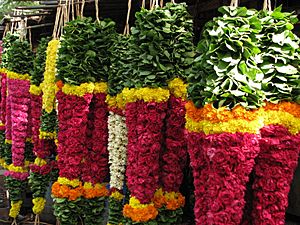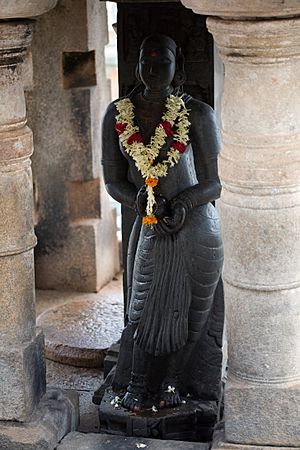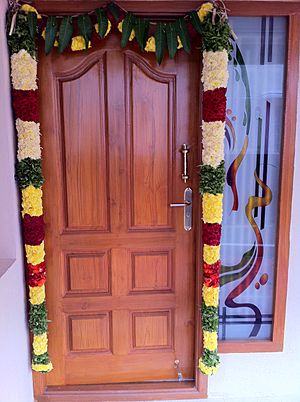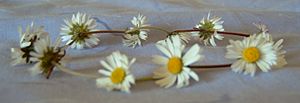Garland facts for kids
A garland is a beautiful decoration made from flowers, leaves, or other materials. People wear garlands on their heads or around their necks. You can also hang them on objects or place them in special spots for cultural or religious reasons.

Contents
What's in a Name? (Etymology)
The word "garland" comes from the French word guirlande. This word itself came from the Italian word ghirlanda, which means "a braid."
Different Types of Garlands
Garlands can be made from many different things:
- Bead garlands
- Flower garlands
- Leis - these are the traditional garlands from Hawaiʻi
- Pennant garlands (like small flags on a string)
- Pine garlands
- Popcorn and/or cranberry garlands
- Rope garlands
- Tinsel garlands (often seen at Christmas)
- Vine garlands
- Balloon garlands
- Mundamala (a special type of garland)
Making a Daisy Chain
A daisy chain is a garland made from daisy flowers. Kids often make them as a fun game! One way to make a daisy chain is to pick daisies and make a small hole near the bottom of the stem, perhaps with your fingernail. Then, you thread the stem of the next flower through the hole. The flower's head will stop it from pulling all the way through. By doing this with many daisies, you can create long chains. You can even shape them into simple bracelets or necklaces.
Garlands in Stories and Poems

Garlands appear in many famous stories and poems.
In Alice's Adventures in Wonderland by Lewis Carroll, Alice is thinking about making a daisy chain with her sister right before she meets the White Rabbit and her adventures begin.
Garlands in Poetry
- Garlands are mentioned in poems like "La Belle Dame sans Merci" by John Keats.
- In the Bible, a verse in Proverbs (4:9) talks about wisdom giving you a "graceful garland" and a "beautiful crown."
- In the 1913 book The Golden Road by Lucy M. Montgomery, a "fading garland" is used to describe getting older or the end of life. It suggests that someone's life ended while they were still young and happy, before their "rose of joy" lost any petals.
- In the 1906 children's book The Railway Children by Edith Nesbit, a garland is used as a symbol for friendship. The book says, "Let the garland of friendship be ever green."
Garlands Around the World
India
Garlands for Festivals and Deities

In India, flower garlands are very important and traditional for almost every festival. Hindu deities (gods and goddesses) are often decorated with garlands. These garlands are made from many different sweet-smelling flowers, like jasmine, and special leaves. Both fragrant and non-fragrant flowers, along with leaves important in religion, are used.
Some popular flowers for garlands include:
- jasmine
- champaka
- lotus
- lily
- ashoka
- nerium/oleander
- chrysanthemum
- rose
- hibiscus
- pinwheel flower
- manoranjini

Besides flowers, leaves and grasses like arugampul, maruvakam, davanam, maachi, paneer leaves, and lavancha are also used. Sometimes, garlands are even made from fruits, vegetables, or money notes as a way to show thanks.
At wedding ceremonies in India, the bride and groom wear special wedding garlands. Garlands are also given as a sign of respect to people or to divine images.
A gajra is a flower garland that women in India and Bangladesh wear in their hair during traditional festivals. It's usually made with jasmine. Women often wear them around a hair bun or woven into braids, especially when they wear sarees. Sometimes, they also pin other flowers like roses with the gajra.
South Indian Garland Traditions
In ancient times, Tamil kings hired people just to make garlands every day for specific deities. These special garlands were not for everyone to use.
Today, many Hindu temples in southern India have a nandavanam, which is a flower garden. Here, they grow the flowers and trees needed for garlands. Large Shiva temples, like Thillai Nataraja Temple, Chidambaram and Arunachaleswara Temple, still have these gardens to provide flowers for daily rituals.
Stone writings from King Rajaraja I in Thanjavur show how much royal families supported keeping these temple gardens healthy.
Some garlands, like those made from marigold and nitya kalyani, are only used in burial ceremonies. At social events, garlands are used to show who the host is.
At the Srirangam Ranganathar temple, only garlands made by the temple's sattharars (people who make garlands for the temple) are used to decorate the deity Ranganatha. Flowers and garlands from outside the temple are not allowed. The sattarars follow strict rules for their work:
- Flowers should be picked early in the morning.
- No one should smell the flowers.
- Flowers should only be picked after bathing.
- Flowers that have fallen from the plant and touched the ground should not be used.
- They should repeat holy names (Namajapam) while picking flowers.
When making garlands, the sattarars keep flowers and materials on a table. This is to keep them away from their feet, as feet are traditionally seen as unclean for religious items. All materials are kept above hip level.
South Indian garlands come in different types:
- Thodutha maalai: These garlands are made from the fiber of the banana tree (vaazhainaar). They are common in marriage ceremonies and for religious offerings. In Hindu weddings, the bride and groom exchange garlands three times. These garlands can be from 1.5 feet to 12 feet long and 2 inches to 3/4 feet thick.
- Kortha maalai: These are made using a needle and thread. Garlands of jasmine, mullai, and lotus are made this way. Garlands for gods have two loose ends with a bunch of flowers (kunjam) at the bottom, meaning only the top ends are joined. Garlands for people have both lower ends joined together.
Each Hindu deity often has a special garland:
- Lalitha wears hibiscus
- Vishnu wears tulasi leaves
- Shiva wears bilva leaves
- Subrahmanya wears jasmine
- Lakshmi wears red lotus
- Sarasvati wears white lotus
- Durga wears nerium oleander
- Vinayaka wears dūrvā grass
The tradition of putting garlands on statues as a sign of respect also extends to important non-religious figures, like the ancient King Perumbidugu Mutharaiyar II and the colonial administrator Mark Cubbon.
Nepal
Garlands are even mentioned in the Nepalese national anthem, Sayaun Thunga Phulka. The first line says, "Woven from hundreds of flowers, we are one garland that's Nepali."
See also
 In Spanish: Guirnalda para niños
In Spanish: Guirnalda para niños


